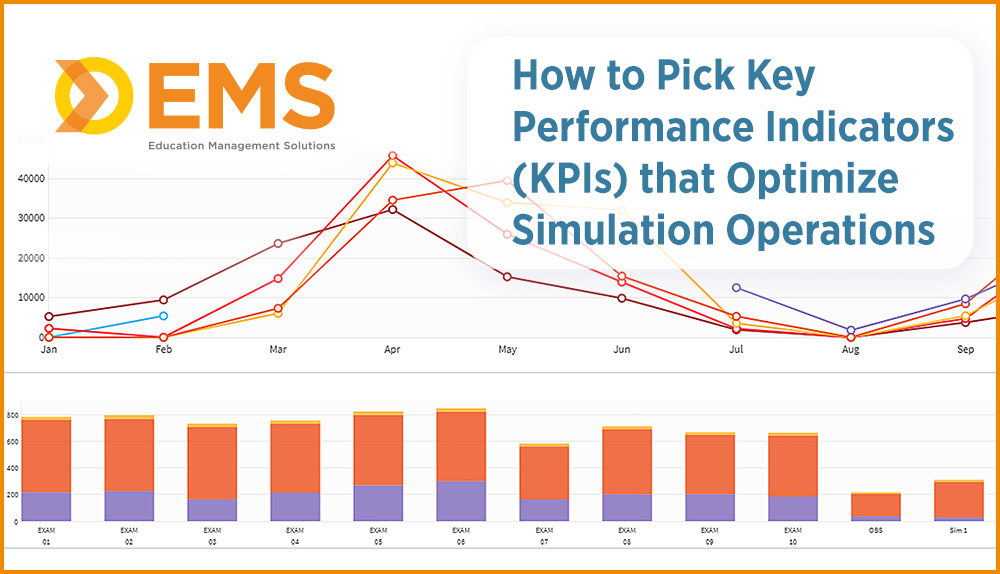How to Pick Key Performance Indicators (KPIs) that Optimize Healthcare Simulation Outcomes
Reports, metrics, and key performance indicators (KPIs) are everywhere—but with a bit of planning and the technology to back you up, you can make the numbers work for your healthcare simulation program. Start with a primary focus on metrics that are most relevant to your goals, and take time to consider why and how a KPI is crucial to improving your simulation training outcomes. Read on for ways to select – and make the most – of KPIs at your institution.
What is a KPI?
A KPI is a type of measurement that evaluates the success of an organization or of a particular activity (such as projects, programs, products and other initiatives) in which it engages. KPIs provide a focus for strategic and operational development, create an analytical basis for decision making, and help bring attention the metrics that matter most.
Sponsored Content:
Defining KPIs for simulation
For healthcare education programs, KPIs should help administrators measure training data and manage simulation center activities. Performance indicators for a simulation center may examine cases and scenarios, learner evaluations, video recordings, system usage, user and login data, and more.
Selecting KPIs for improved simulation operations
1. Have direction: Select KPIs that are aligned with your training objectives. The ultimate goal of simulation-based training is to improve outcomes. Your KPIs should reflect that. Simulation-based training provides an excellent opportunity for healthcare practitioners to refine care delivery and team-based communication skills in a safe environment. If you’re conducting an in-situ cross-discipline training exercise, you might select KPIs related to communication, and measure how frequently various clinicians are in communication with one another with a goal of increasing the quality of care for the patient. And a KPI measuring facility utilization might examine who uses your lab/center, when, and for what purpose.
Sponsored Content:
2. Be precise: Select KPIs that are well-defined. Before you get started, outline what exactly it is you are measuring, and ask yourself what data points you need to make a measurement. KPIs for simulation training outcomes should communicate a clear understanding of both methodology and anticipated results. If a KPI is too vague, it may be interpreted in different ways. Use reports to keep everyone on the same page and moving forward in the same direction.
3. Be realistic: Select KPIs that are measurable with the tools and technology you have. Realistic planning will enable you to generate reports from evaluations, scores, performance, surveys, and create center/inventory usage statistics.
4. Make the most of your data: Select KPIs that inspire action. Once you’ve collected and analyzed your KPIs, you’ll want to make the most of the results. If your learners are consistently meeting – or missing – required competencies, your KPIs can guide you in modifying your curricula. Comprehensive KPIs for video recording, evaluation, cases and scenarios, users and login, center utilization, and system usage can help you make informed choices as you refine your training program and plan for the future. Try to start with a primary focus on metrics that are most relevant to your program, and take the time to think critically about how and why a certain KPI is key to improving simulation training outcomes.
KPI case study – Center Utilization Reporting: An innovative add-on application can help you conduct in-depth reporting and review comprehensive KPIs, monitor trends, and generate a variety of charts on simulation activities.
For example, consider how you can streamline your operations by automating center utilization reporting at your institution. Start by building simple templates of the scenarios that you regularly run every year or semester. These templates may include a name, the scenario duration, and list the larger capital equipment (mannequins) needed in the scenario. Schedule the scenarios as needed, and the application will track usage of equipment, rooms, and users, and generate easy to understand utilization charts that are updated in real time and can be accessed or edited on a secure, per-user basis.
Tools to Facilitate Simulation Management from EMS: DashboardKPI
You already have a sim center, but what’s the proof that your training initiatives are really working? Are you tracking return on investment (ROI)?
Take charge of your sim center activities and plan for the future with powerful real time analytics. DashboardKPI, an innovative app integrated with EMS’ SIMULATIONiQ Enterprise, makes it easy to monitor trends and generate charts on simulation activities.
DashboardKPI also allows you to review comprehensive KPIs for video recording, evaluation, cases and scenarios, users and login, system usage, and more.
For more on managing your simulation-based training program, secure their free 10-Point Checklist for Maximizing ROI with Simulation Management Technology through the link below.
The simulation community has been challenged to show return on investment (ROI) for simulation programs and centers. Request the tip sheet to discover ten ways simulation management technology can help you take charge of your operations, define your goals, analyze your data, and make the most of your investment.
About Education Management Solutions (EMS)
Medical, nursing, and allied health schools, hospitals, and counseling programs use EMS’ suite of products to more efficiently manage clinical simulation centers, effectively evaluate learner performance, and digitally document simulated events. As a leader in clinical simulation management technology since its founding in 1994, EMS provides a complete turnkey solution that includes integrated software and hardware, design and planning, engineering, configuration, installation, training, and support.
Learn more about Picking KPIs that Optimize!
Sponsored Content:

















